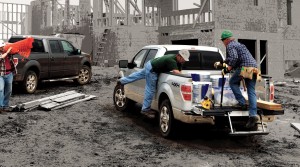Two Ford truck plants are in the process of slightly upping their production for the balance of the year. The increases were previously announced by Ford as preliminary results from the now ended “Cash for Clunkers” federal rebate program showed sales gains.
The increased production, however welcome, is not the ringing endorsement for the U.S. economy or for manufacturing employment that they might appear to be at first glance. The company continues to pare or restrict the hours of its workforce.
In addition, Ford is forecasting a seasonally adjusted selling rate of between 10 and 11 million vehicles for 2009, down from a dismal 2008, which started out the year at more than 15 million vehicles and then steadily declined to 10 million units by December. All told, 2008 ended with vehicle sales of 13.2 million units, the lowest level since 1992.
As it stands now the Dearborn Truck Plant in Michigan, will resume a three-shift operation in September, to supply F-150 pickups in the U.S. and Canada. The move will result in a return to full-time employment for 2,800 employees who had been working on a two-weeks-on and one-week-off rotating basis since last April.
It’s becoming clear that conventional wisdom about the invincible Japanese is wrong. Toyota and Nissan, not American makers, have been trounced in the pickup truck wars; and have lost billions on their investments in large trucks. Ford, General Motors and, to a lessor degree, Dodge remain the dominate players in this segment, which represents 12% to 15% of the market.
Ford is also establishing three-crew shifts this October at its Kansas City Assembly Plant in Claycomo, Missouri. Compact Ford Escape and Mercury Mariner sport utility vehicles are built there.
The addition of a third crew on the SUV line at Kansas City Assembly, when combined with previously announced overtime at the plant that began earlier this month, will deliver approximately 2,400 additional Escapes and Mariners by the end of October. However, employment levels remain unchanged, as the plant is also eliminating one shift of production on its pickup truck line beginning in mid-October.
F-series production changes will result in about 10,000 additional units for the balance of the year. To put this in perspective in the boom years of more than 15 million units annually, Ford Division alone sold 10,000 vehicles a day.
Ford says that it is on track to post in August its highest monthly F-Series and Escape sales of 2009 following good sales for both vehicles in July. F-Series truck sales have been declining since October 2006. Year-to-date Ford sales are off 28%.
Still, Ford plans to produce 570,000 vehicles in the fourth quarter, a 33% increase versus the depressed year-ago levels when all makers cut back; and 15% above planned third quarter 2009 levels. The increase represents higher production across a range of cars, crossovers and trucks.
The actual sales results for the U.S. industry will not be out until next week, but it is widely expected that “Clunkers” spurred the biggest month in August of what has been a depressed 2009 sales year, which saw sales at their lowest levels in four decades.

